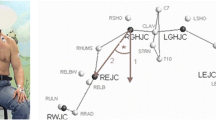Abstract
Shoulder arthroplasty is well established as a method to treat osteoarthritis of the shoulder. This study was designed to report early results of a new anatomic designed shoulder prosthesis with a special designed “double excenter mechanism” for restoration of the proximal humerus. Between 2004 and 2005, 20 patients were treated with the Affinis® shoulder prosthesis and were examined 1 day before, and at 3 and 9 months after surgery. The average postoperative anteversion, abduction and external rotation was 138.2°, 104.3° and 58.2° respectively. With regard to abduction and external rotation no significant improvement from 3 to 9 month after shoulder arthroplasty was found (p=0.14, p=0.06 respectively). The mean Constant score, non adjusted related to age and gender, improved from 29.9±11.0 points preoperatively to 60.3±10.5 points 9 months after surgery and the Dash score improved from 59.8±13.5 points preoperatively to 31.9±17.9 points after surgery. The analysis of the distribution of required humerus head and conus position to restore the motion centre demonstrated a wide variability of the geometry of the proximal humerus and the need of a wide adjustment range in medial-lateral direction as well as in anterior posterior direction for the anatomic reconstruction of the rotation centre.
Zusammenfassung
Die Schultergelenksendoprothetik ist ein etabliertes Verfahren zur Behandlung der konservativ nicht mehr beherrschbaren primären und sekundären Omarthrose.Diese Studie evaluiert die frühfunktionellen Ergebnisse einer neu entwickelten anatomischen Schulterprothese. Weiterhin wurde untersucht, inwieweit sich die Anatomie des proximalen Humerus durch den „Doppelexzenter“-Mechanismus dieser Prothese wiederherstellen lässt. Zwischen 2004 und 2005 wurde bei 20 Patienten mit primärer Omarthrose eine Affinis® Schulterprothese implantiert. Die Patienten wurden präoperativ, sowie 3 und 9 Monate postoperativ klinisch und radiologisch untersucht. Die postoperative Anteversion, Abduktion und Außenrotation betrug 138,2°, 104,3° und 58,2°. In Bezug auf die Abduktion und Außenrotation zeigten sich keine signifikanten Unterschiede zwischen dem 3. und 9 Monat postoperativ (p=0,14, p=0,06). Der mittlere, nicht alters- und geschlechtskorrelierte Constant Score verbesserte sich von 29,9±11,0 Punkte auf 60,3±10,5 Punkte postoperativ und der Dash Score verbesserte sich von 59,8±13,8 Punkte auf 31,9±17,9 Punkte postoperativ. Die Analyse der Verteilung der erforderlichen Konus- und Kopfpositionen der Humeruskomponente zur Rekonstruktion des Drehzentrums des Glenohumeral-Gelenkes zeigte eine hohe Variabilität der Geometrie des proximalen Humerus. Dies unterstreicht die Erfordernis einer weiten Adjustierungsmöglichkeit des Prothesenkopfes sowohl in mediolateraler als auch in anterior-posteriorer Richtung, um die Kopfexzentrizität wieder rekonstruieren zu können.
Similar content being viewed by others
Literatur
Arman F (2003) Total shoulder arthroplasty vs. hemiarthroplasty. Zentralbl Chir 128(1):17-21
Boileau P, Walch G (1997) The three-dimensional geometry of the proximal humerus. Implications for surgical technique and prosthetic design. J Bone Joint Surg Br 79(5):857-86
Bryant D, Litchfield R, Sandow M, Gartsman GM, Guyatt G, Kirkley A (2005) A comparison of pain, strength, range of motion, and functional outcomes after hemiarthroplasty and total shoulder arthroplasty in patients with osteoarthritis of the shoulder. A systematic review and meta-analysis. J Bone Joint Surg Am 87(9):1947-1956
Buchler P, Farron A (2004) Benefits of an anatomical reconstruction of the humeral head during shoulder arthroplasty: a finite element analysis. Clin Biomech (Bristol, Avon) 19(1):16-23
Churchill RS, Kopjar B, Fehringer EV, Boorman RS, Matsen FA III (2005) Humeral component modularity may not be an important factor in the outcome of shoulder arthroplasty for glenohumeral osteoarthritis. Am J Orthop 34(4):173-176
Constant CR, Murley AH (1987) A clinical method of functional assessment of the shoulder. Clin Orthop Relat Res 214:160-164
Deshmukh AV, Koris M, Zurakowski D, Thornhill TS (2005) Total shoulder arthroplasty: long-term survivorship, functional outcome, and quality of life. J Shoulder Elbow Surg 14(5):471-479
Edwards TB, Kadakia NR, Boulahia A, Kempf JF, Boileau P, Nemoz C, Walch G (2003) A comparison of hemiarthroplasty and total shoulder arthroplasty in the treatment of primary glenohumeral osteoarthritis: results of a multicenter study. J Shoulder Elbow Surg 12(3):207-213
Gaullier O (2004) “Geometry of the proximal humerus and implications for prosthetic design” by Hertel R et al. J Shoulder Elbow Surg 13(1):126-127
Habermeyer P (1995) Alloarthroplastik des Schultergelenkes. Habermeyer P, Schweiberer L (eds) Schulterchirurgie, S. 305–325. München, Wien, Baltimore, Urban and Schwarzenberg
Habermeyer P, Ebert T (1999) Current status and perspectives of shoulder replacement. Unfallchirurg 102(9):668-683
Hammond JW, Queale WS, Kim TK, Mc-Farland EG (2003) Surgeon experience and clinical and economic outcomes for shoulder arthroplasty. J Bone Joint Surg Am 85-A(12):2318-2324
Heers G, Grifka J, An KN (2001) Biomechanical considerations on shoulder joint prosthesis implantation. Orthopäde 30(6):346-353
Hertel R, Knothe U, Ballmer FT (2002) Geometry of the proximal humerus and implications for prosthetic design. J Shoulder Elbow Surg 11(4):331-338
Hettrich CM, Weldon E III, Boorman RS, Parsons IM, Matsen FA III (2004) Preoperative factors associated with improvements in shoulder function after humeral hemiarthroplasty. J Bone Joint Surg Am 86-A(7):1446-1451
Hudak PL, Amadio PC, Bombardier C (1996) Development of an upper extremity outcome measure: the DASH (disabilities of the arm, shoulder and hand) [corrected]. The Upper Extremity Collaborative Group (UECG). Am J Ind Med 29(6):602-608
Iannotti JP, Gabriel JP, Schneck SL, Evans BG, Misra S (1992) The normal glenohumeral relationships. An anatomical study of one hundred and forty shoulders. J Bone Joint Surg Am 74(4):491-500
Iannotti JP, Spencer EE, Winter U, Deffenbaugh D, Williams G (2005) Prosthetic positioning in total shoulder arthroplasty. J Shoulder Elbow Surg 14(Suppl 1):S111-S121
Kellgren JH, Lawrence JS (1957) Radiological Assessment of Osteo-Arthrosis. Ann Rheum Dis 16:494-501
Author information
Authors and Affiliations
Corresponding author
Additional information
Diese Arbeit wurde unterstützt durch die Deutsche Arthrose Hilfe e.V.
Rights and permissions
About this article
Cite this article
Berth, A., Pap, G. Konzept und frühfunktionelle Ergebnisse eines neuen Doppelexzenter-Schulter-Prothesensystems. Obere Extremität 2, 73–80 (2007). https://doi.org/10.1007/s11678-007-0035-4
Received:
Accepted:
Issue Date:
DOI: https://doi.org/10.1007/s11678-007-0035-4




